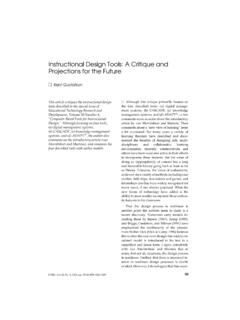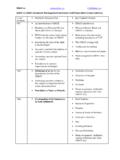Transcription of A History of Instructional Design and Technology: …
1 A History of Instructional Design and Technology: Part II: A History of Instructional DesignRobert A. ReiserThis is the second of a two-part article thatdiscusses the History of the field ofinstructional Design and technology in theUnited States. The first part, which focused onthe History of Instructional media, appeared inthe previous issue of this journal (volume 49,number 1). This part of the article focuses onthe History of Instructional Design . Startingwith a description of the efforts to developtraining programs during World War II, andcontinuing on through the publication of someof the first Instructional Design models in the1960s and 1970s, major events in thedevelopment of the Instructional designprocess are described. Factors that haveaffected the field of Instructional Design overthe last two decades, including increasinginterest in cognitive psychology,microcomputers, performance technology, andconstructivism, are also Part I of this article, I presented the follow-ing definition of the field of Instructional designand Technology: The field of Instructional Design and technologyencompasses the analysis of learning and performanceproblems, and the Design , development, implementa-tion, evaluation and management of Instructional andnoninstructional processes and resources intended toimprove learning and performance in a variety of set-tings, particularly educational institutions and theworkplace.
2 Professionals in the field of instructionaldesign and technology often use systematic instruc-tional Design procedures and employ a variety ofinstructional media to accomplish their goals. More-over, in recent years, they have paid increasing atten-tion to noninstructional solutions to some performanceproblems. Research and theory related to each of theaforementioned areas is also an important part of thefield. (Reiser, in press)As was pointed out in Part I, the major fea-tures of this definition include (a) its listing of sixcategories of activities or practices (analysis, Design , development, implementation, evalua-tion, and management) often associated with thefield; (b) its identification of research and theory,as well as practice, as important aspects of theprofession; and (c) its recognition of the influ-ence the performance technology movement hashad on professional practices.
3 Moreover, thedefinition highlights two practices that have,over the years, formed the core of the two practices are (a) the use of media forinstructional purposes and (b) the use of systematicinstructional Design procedures (often simplycalled Instructional Design ). As was mentioned inPart I, although many have argued about thevalue of employing these practices, they remainas the key defining elements of the field ofETR&D, Vol. 49, No. 2, 2001, pp. 57 67 ISSN 1042 162957 AAH GRAPHICS, INC. / (540) 933-6210 / FAX 933-6523 / 05-30-2001 / 10:39instructional Design and technology. Individu-als involved in the field are those who spend asignificant portion of their time working withmedia, or with tasks associated with systematicinstructional Design procedures, or with Part I, I discussed the History of instruc-tional media.
4 In Part II, I will focus on the historyof Instructional Design . This is a natural separa-tion because, from a historical perspective, mostof the practices related to Instructional mediahave occurred independent of developmentsassociated with Instructional Design . It shouldalso be noted that although many importantevents in the History of the field have taken placein other countries, the emphasis in both parts ofthis article is on events that have taken place inthe United OF Instructional DESIGNOver the past four decades, a variety of sets ofsystematic Instructional Design procedures (ormodels) have been developed, and have beenreferred to by such terms as the systems approach, Instructional systems Design (ISD), instructionaldevelopment, and Instructional Design (which is theterm I will usually employ in this article).
5 Although the specific combination of proce-dures often varies from one Instructional designmodel to the next, most of the models includethe analysis of Instructional problems, and thedesign, development, implementation and eval-uation of Instructional procedures and materialsintended to solve those problems. How did thisinstructional Design process come into being?This article will focus on answering that Origins of Instructional Design :World War IIThe origins of Instructional Design procedureshave been traced to World War II (Dick, 1987).During the war, a large number of psychologistsand educators who had training and experiencein conducting experimental research were calledon to conduct research and develop trainingmaterials for the military services.
6 These indi-viduals, including Robert Gagn , Leslie Briggs,John Flanagan, and many others, exerted con-siderable influence on the characteristics of thetraining materials that were developed, basingmuch of their work on Instructional principlesderived from research and theory on instruction,learning, and human behavior (Baker, 1973;Dick, 1987; Saettler, 1990).Moreover, psychologists used their knowl-edge of evaluation and testing to help assess theskills of trainees and select the individuals whowere most likely to benefit from particular train-ing programs. For example, at one point in thewar, the failure rate in a particular flight trainingprogram was unacceptably high. In order toovercome this problem, psychologists examinedthe general intellectual, psychomotor and per-ceptual skills of individuals who were able tosuccessfully perform the skills taught in the pro-gram, and then developed tests that measuredthose traits.
7 These tests were used to screen can-didates for the program, with those individualswho scored poorly being directed into other pro-grams. As a result of using this examination ofentry skills as a screening device, the militarywas able to significantly increase the percentageof personnel who successfully completed theprogram (Gagn , personal communication,1985).Immediately after World War II, many of thepsychologists responsible for the success of themilitary training programs continued to workon solving Instructional problems. Organiza-tions such as the American Institutes forResearch were established for this purpose. Dur-ing the late 1940s and throughout the 1950s, psy-chologists working for such organizationsstarted viewing training as a system, and devel-oped a number of innovative analysis, Design ,and evaluation procedures (Dick, 1987).
8 Forexample, during this period, a detailed taskanalysis methodology was developed by RobertB. Miller while he worked on projects for themilitary (Miller,1953, 1962). His work and that ofother early pioneers in the Instructional designfield is summarized in Psychological Principles inSystem Development, edited by Gagn (1962b).AAH GRAPHICS, INC. / (540) 933-6210 / FAX 933-6523 / 05-30-2001 / 10:3958 ETR&D, Vol. 49, No. 2 More Early Developments: TheProgrammed Instruction MovementThe programmed instruction movement, whichran from the mid-1950s through the mid-1960s,proved to be another major factor in the devel-opment of the systems approach. In 1954, s article entitled The Science of Learningand the Art of Teaching began what might becalled a minor revolution in the field of educa-tion.
9 In this article and later ones ( , Skin-ner,1958), Skinner described his ideas regardingthe requirements for increasing human learningand the desired characteristics of effectiveinstructional materials. Skinner stated that suchmaterials, called programmed instructionalmaterials, should present instruction in smallsteps, require overt responses to frequent ques-tions, provide immediate feedback, and allowfor learner self-pacing. Moreover, because eachstep was small, it was thought that learnerswould answer all questions correctly and thusbe positively reinforced by the feedback process Skinner and others (cf. Lumsda-ine & Glaser, 1960) described for developingprogrammed instruction exemplified an empiri-cal approach to solving educational problems:Data regarding the effectiveness of the materialswere collected, Instructional weaknesses wereidentified, and the materials were revisedaccordingly.
10 In addition to this trial and revisionprocedure, which today would be called forma-tive evaluation, the process for developing pro-grammed materials involved many of the stepsfound in current Instructional Design models. AsHeinich (1970) indicated:Programmed instruction has been credited by somewith introducing the systems approach to analyzing and breaking down content into specificbehavioral objectives, devising the necessary steps toachieve the objectives, setting up procedures to try outand revise the steps, and validating the programagainst attainment of the objectives, programmedinstruction succeeded in creating a small but effectiveself- Instructional system a technology of instruction.(p. 123)The Popularization of BehavioralObjectivesAs indicated above, those involved in designingprogrammed Instructional materials oftenbegan by identifying the specific objectiveslearners who used the materials would beexpected to attain.









